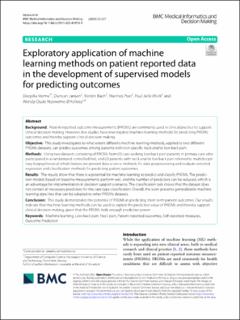| dc.contributor.author | Verma, Deepika | |
| dc.contributor.author | Jansen, Duncan | |
| dc.contributor.author | Bach, Kerstin | |
| dc.contributor.author | Poel, Mannes | |
| dc.contributor.author | Mork, Paul Jarle | |
| dc.contributor.author | Oude Nijeweme d’Hollosy, Wendy | |
| dc.date.accessioned | 2023-01-13T07:01:48Z | |
| dc.date.available | 2023-01-13T07:01:48Z | |
| dc.date.created | 2022-09-01T15:28:27Z | |
| dc.date.issued | 2022 | |
| dc.identifier.issn | 1472-6947 | |
| dc.identifier.uri | https://hdl.handle.net/11250/3043203 | |
| dc.description.abstract | Background
Patient-reported outcome measurements (PROMs) are commonly used in clinical practice to support clinical decision making. However, few studies have investigated machine learning methods for predicting PROMs outcomes and thereby support clinical decision making.
Objective
This study investigates to what extent different machine learning methods, applied to two different PROMs datasets, can predict outcomes among patients with non-specific neck and/or low back pain.
Methods
Using two datasets consisting of PROMs from (1) care-seeking low back pain patients in primary care who participated in a randomized controlled trial, and (2) patients with neck and/or low back pain referred to multidisciplinary biopsychosocial rehabilitation, we present data science methods for data prepossessing and evaluate selected regression and classification methods for predicting patient outcomes.
Results
The results show that there is a potential for machine learning to predict and classify PROMs. The prediction models based on baseline measurements perform well, and the number of predictors can be reduced, which is an advantage for implementation in decision support scenarios. The classification task shows that the dataset does not contain all necessary predictors for the care type classification. Overall, the work presents generalizable machine learning pipelines that can be adapted to other PROMs datasets.
Conclusion
This study demonstrates the potential of PROMs in predicting short-term patient outcomes. Our results indicate that machine learning methods can be used to exploit the predictive value of PROMs and thereby support clinical decision making, given that the PROMs hold enough predictive power | en_US |
| dc.language.iso | eng | en_US |
| dc.publisher | BMC | en_US |
| dc.rights | Navngivelse 4.0 Internasjonal | * |
| dc.rights.uri | http://creativecommons.org/licenses/by/4.0/deed.no | * |
| dc.title | Exploratory application of machine learning methods on patient reported data in the development of supervised models for predicting outcomes | en_US |
| dc.title.alternative | Exploratory application of machine learning methods on patient reported data in the development of supervised models for predicting outcomes | en_US |
| dc.type | Peer reviewed | en_US |
| dc.type | Journal article | en_US |
| dc.description.version | publishedVersion | en_US |
| dc.source.volume | 22 | en_US |
| dc.source.journal | BMC Medical Informatics and Decision Making | en_US |
| dc.identifier.doi | https://doi.org/10.1186/s12911-022-01973-9 | |
| dc.identifier.cristin | 2047968 | |
| cristin.ispublished | true | |
| cristin.fulltext | postprint | |
| cristin.qualitycode | 1 | |

